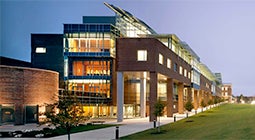X-Ray Diffractometer (XRD)
This instrument is used to characterize materials in terms of internal dimensions that are roughly the size of a chemical bond (Ångstrom scale) by means of X-Ray diffraction.
Typical samples are powders* and thin films on substrates such as silicon wafers. This is NOT a tool for solving crystallographic structures.
*Here a powder means a sample that is not a single crystal, but is made up of crys-tallites (microscopic crystals) oriented randomly in all possible directions.
- Powder X-ray Diffraction (XRD)
- Variable Temperature XRD (-100 C to +350 C)
- High-Resolution XRD (HR-XRD)
- Pole Figures
- Reciprocal Space Mapping (RSM)
- X-Ray Reflection (XRR)
- Out-of-plane Grazing Incidence (OOP-GID)
The instrument has a Theta/2-Theta configuration, meaning that for standard powder XRD measurements the X-Ray source remains stationary while the detector is rotated though the full scattering angle (2-Theta) and the sample is rotated though half of the scattering angle (Theta). The main Theta/2Theta goniometer is sits horizontally, meaning that rotation is like a photograph record. Samples sit vertically.
The instrument uses a “Parallel Beam” geometry in which the X-ray beam is fo-cused to a line by means of a Göbel mirror. Bragg-Brentano geometry is not availa-ble. The detector is a single-pixel Thalium-doped sodium-iodide [NaI(Tl)] scintilla-tion detector. There is an in-line attenuator that can dynamically limit the intensity of the X-ray beam during a scan to protect the detector and prevent it from satu-rating.
The sample is held in a “Eulerian Cradle” that sits atop the Theta drive. The cradle has additional motorized drives for Phi, Chi, X, Y, and Y. The Z-drive moves the sample along an axis at 90-degrees to the X-ray beam, and is used to align the face of the same with the center of the x-ray beam. The Phi and Chi drives rotate the sample and are used for Pole Figures. The instrument has an additional drive that can make small rotations of the X-ray source centered on the sample. This drive is used for In-plane Grazing Incidence (IP-GID) measurements.
Additional hardware:
- Vacuum chuck (5 inch diameter) to hold wafer samples.
- Heated and cooled sample stage (Anton-Parr DCS-350)
- Incident-beam monochromator: 4-bounce germanium assymetric
- Diffracted-beam monochromator: Bruker “Pathfinder.” This optic can switch be-tween a 3-bounce germanium monochromator and slit collimation under computer control.
- Bruker “Parallel Beam Attachment” – a diffracted-beam optic consisting of a sin-gle large Soller slit with plates oriented vertically, i.e., parallel to the collimating slit.
Equipment Rates & Fees
| RPI Users | External Nonprofit | External Industry | External Industry Partners | |
|---|---|---|---|---|
| Standard | $58 | $95 | $191 | $172 |
| Assisted | $116 | $191 | $382 | $343 |
| Training | $89 | $146 | $293 | $264 |
| Night-Flat Rate* | $400 | $658 | $1316 | $1184 |
| RPI Users | External Nonprofit | External Industry | External Industry Partners | |
|---|---|---|---|---|
| Personnel Time | $77 | $127 | $253 | $228 |
Effective August 1, 2025 through July 31, 2026. Rates are hourly unless specified otherwise and are subject to change without further notice.
Required Acknowledgement and Authorship
Please acknowledge the CBIS Core Facilities in all publications and grant applications where our equipment and/or personnel have facilitated the work. These acknowledgements are very important because documenting our contributions helps to ensure that the resources of the Core Facilities are sustainable.
- Equipment: If you used Core Facility equipment, please note this in the Materials and Methods. e.g., Thermogravimetric analysis was carried out using a TA Instruments TGA-Q50 (Rensselaer CBIS Analytical Biochemistry Core Facility).
- Personnel: Please consider including CBIS personnel as co-authors on your publications when they have made a significant intellectual contribution to the research. Include CBIS Core Facility directors or staff as co-PI or co-investigators in grant applications when they provide a significant contribution to the grant proposal and scientific/intellectual leadership for the proposed work. Please follow these guidelines: ABRF Recommended Guidelines for Authorship on Manuscripts. Also, our Core Facility personnel always appreciate when they are mentioned in the Acknowledgements section of publications.
- Required Funding Authorization Form: Rensselaer researchers must fill out the CBIS Cores Authorization Form (PDF) to use the CBIS Core Facilities.
